Death closes all: but something ere the end,
Some work of noble note, may yet be done,
Not unbecoming men that strove with Gods.(from Alfred, Lord Tennyson’s ‘Ulysses’)
The 36-year-old Basque matador Iván Fandiño was killed by a bull in the ring yesterday in Aire-Sur-L’Adour, near Mont de Marsan, in the Nouvelle-Aquitaine region of southwestern France.
The bull, Provechito No. 53, was born in March 2013 in El Escorial in the province of Madrid, on the well-known as respect ranch of Baltasar Ibán – founded 1920 – whose herd is of the Contreras bloodline – whose origin is the historic Murubé line – with a touch of Domecq – whose origin is the historic Parladé line.
It was the third of six bulls fought that evening, and was actually being fought by the matador Juan del Álamo when Fandiño stepped in to perform a quite upon it – a sequence of artistic manoeuvres with cape done after the bull has faced the mounted picador with his lance.
This is not an uncommon occurrence in the centuries-old scripted sequence of a corrida. The corrida is not a sport, nor a fight (even though I use that English verb as “torear” has no proper translation) – nor thought of, discussed or reviewed in the papers as such. It is a tragic spectacle culminating in a ritual sacrifice.
Fandiño had already been awarded an ear from his own bull, the first of the evening as most senior matador – he became a full matador in 2005 in Bilbao (he was the only Basque matador at the time of his death) – and clearly thought this bull special enough that he could do something to entertain, impress or move the audience with it.
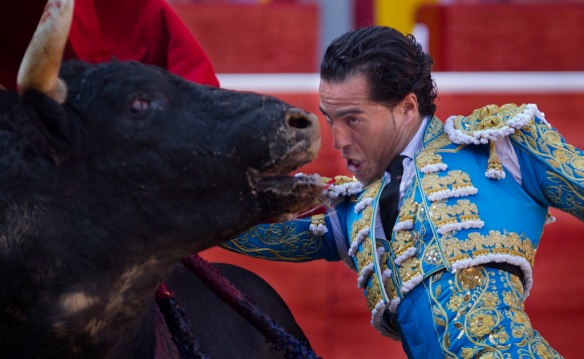
July 11, 2013-Pamplona, Spain- Matador Iván Fandiño does a pase de pecho with a bull from the ranch of Torrestrella of Álvaro Domecq (Photo © Jim Hollander / EPA)
However, he ended up on the ground and from the photographs it seems that its right horn entered the right side of his chest from behind, splintering ribs, destroying the lung and penetrating the cardiac blood systems.
He was carried from the ring by the other toreros present and his last words were spoken to the matador Juan del Álamo as he helped carry him to the infirmary: “Hurry up and get me to the hospital, I’m dying.”
While the infirmary of a category one plaza de toros like Seville, the capital city of Andalusia – which I am sitting outside as I write this – is the equivalent of a modern trauma centre, with thirteen medical staff on standby, including three famous surgeons experienced in every type of horn wound, that of the place des taureaux in rural Aire-Sur-L’Adour, population 6,000, would have been very different.
Fandiño was stabilised there as best they could and swiftly placed in an ambulance in which he died after a second heart attack on the half hour journey to the hospital in Mont de Marsan.
On the ethics of bullfighting I have written much on this blog, see this post for example (the post below this, ‘An Essay On Bullfighting’, gives the whole story of the corrida), but here I will confine myself to remarking that this bull lived four years and three months – as opposed to the eighteen months regular meat cattle do – and lived wild and free in forest and meadow in a manner no meat cattle can, a landscape funded by the manner of his death: within a public ring in twenty minutes. (Fighting bulls are worth ten times the price of their exclusively-for-meat cousins. One fifth of Spain’s natural landscape, the dehesa, exists on, and is preserved by, the 1,300-or so registered fighting bull ranches.)
The bull was later killed by Juan del Álamo – as previously stated this is not a contest, there is no ‘winning’ – and his meat had, as with all fighting bulls, been pre-sold. The corrida does not pause for death: of anything, of anyone.
The more than three million cattle we kill each year in the UK that we do not need to eat – we kill them for the flavour: we kill them for the entertainment of our palates – and more than ten times that number in the US where 78% are factory farmed and do not see the light of day, could only dream of such a life.
I would also argue the death is also superior: better to die fighting than queuing in terror, although I admit, that is an opinion. To quote the popular Spanish novelist, Arturo Perez-Reverte, “every man should be given the opportunity to die standing up.” I personally do not restrict this only to men…
I met Fandiño on a ranch when I was training myself as a bullfighter as research for my book Into The Arena: The World Of The Spanish Bullfight in 2010. He was a quiet and serious man, but so was everyone – we were in the ring with animals that can kill – and I did not then know that he was on the ascendant. In 2011 he was declared victor of the month long cycle of corridas in the feria of San Isidro in Madrid, and was known for fighting bulls from the hardest ranches – the Miuras who celebrate their 175th anniversary this year*, Pahla, Victorino Martín** – and in 2015 famously faced on his own an entire historic corrida of six bulls from these ranches and similar in the Spanish capital (and Spain’s largest ring.)
However, given the modern audience’s interest in seeing bulls that charge straight and true – usually descended from bloodlines created by the Domecq family – to allow the most artistic dance between man and beast, he did not receive the triumph he craved and became a rather disillusioned, if still extraordinarily impressive man.
So, what of the bulls? There are still around a couple of thousand bullfights of various types each year and over 15,000 bull events – including bull-running as in Pamplona. There are over 10,000 licensed bullfighters, including over 800 full matadors, (2.5% women), almost 4 million Spaniards attended bullfights in 2015, up almost a third of a million since 2011, and almost seven million watched them on TV and the internet combined.
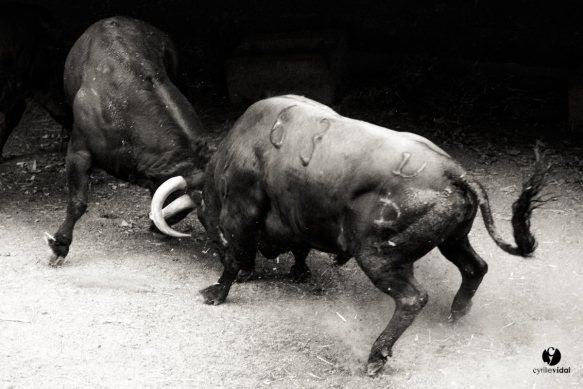
The bulls of Baltasar Ibán before the corrida, in the corrals of Aire-Sur-L’Adour (Photo: Cyrille Vidal)
As for France, many believe it will overtake Spain as the centre of this cultural activity, a move heralded by the French bull-ring empresario Simón Casas taking over the 25,000-seat Madrid bull-ring this year. (The most famous rings in France, run by Casas, are Arles and Nîmes, which are converted coliseums built for Roman gladiators, hence I took their salute as the title for this post.)
Statistics aside, the easiest way to describe how the “world of the bulls” sits in this part of the world of men – and how this tragedy is viewed within it – is anecdotally: I myself am in Seville to finish up editing a book called The Bulls Of Pamplona. When I received the news of Fandiño’s death I was running around the beautiful María Luisa park training for the encierros, ‘bull-runs’, of Pamplona which come in the second week of July. I got the news from my friend Larry Belcher, a former rodeo-rider from Texas and bull-runner who teaches literature and translation at the University of Valladolid (and contributed a chapter to The Bulls Of Pamplona, along with the Mayor of Pamplona, John Hemingway – Ernest’s grandson – Joe Distler, Dennis Clancey and EPA’s Jim Hollander who provided these photos.)
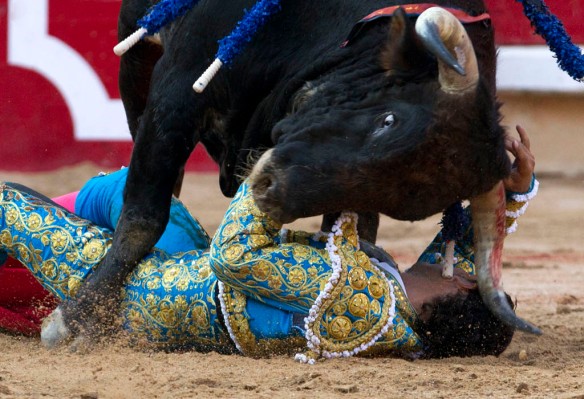
A near miss: Iván Fandiño knocked by a bull from the ranch of Torrestrella of Álvaro Domecq on July 11, 2013 in Pamplona, Spain (Photo © Jim Hollander / EPA)
I read the account of Fandiño’s death and walked down the street to the plaza de toros from my apartment past bars named after matadors – Belmonte, Joselito etc. – with bulls’ heads mounted on their walls. En route I bumped into a young rejoneador, a horse-back bullfighter, called Luis Valdenebro and we discussed the news in serious tones. Then he asked if I would be running with the bulls in Pamplona, and I laughed said “of course”, and he gave me the dates he would also be there and then asked if I would like to get in the ring with him next week, as his father also breeds fighting bulls. My answer was the same: “por supuesto“, ‘of course’.
The emotions were not dissimilar to when my first teacher of toreo, the matador Juan José Padilla, lost his eye in 2011, which I was told about in a text message from the matador Cayetano Rivera Ordóñez – whose father was killed by a bull – a text which went on to invite me back into the ring. (I covered Padilla’s monocular comeback for GQ magazine here.) Or when the matador Victor Barrío was killed last July and I was called immediately after running the bulls in Pamplona to write about it (for The Sun here) and kept running with the bulls for the rest of the week. I’m not sure about “keep calm”, but we definitely “carry on.”
The bulls are central to Spain. And if the cost of maintaining such unifying cultural mythologies is a little public blood along with an improved overall welfare for animals and humans, then I’m all for abandoning the hypocrisy, and facing the truth as it is. Which, like the bulls, favours darkness over light, power over prettiness, harsh reality over concealment and self-deceit.
My condolences to the family of the torero, especially his infant daughter. He died doing what he truly loved and believed in, which is a rare honour. La Plaza de Toros de Las Ventas in Madrid has compiled this video of his most important moments in that ring, king of them all.
P.S. The bull breeder Victorino Martín, whose bulls he so often faced, tweeted this, “Our friend and great torero @ivanfandino died in France. A great loss for the world of the bulls. We are dismayed. RIP.”
Other breeders have done similarly, but obviously it is his fellow matadors who feel this the most. As David Mora – whom I wrote about here – said on Facebook today: “Impossible to express what I feel, dismayed and broken with pain. So many shared evenings, so many memories … Your tireless struggle, your love for your profession, your dedication and greatness. All of that remains with me. Eternal glory is yours. All my support and strength to your family and friends. I will never forget you Ivan. R.I.P. #EternalFandiño”.
Alexander Fiske-Harrison



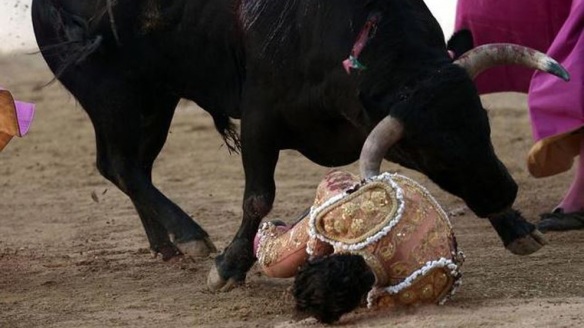
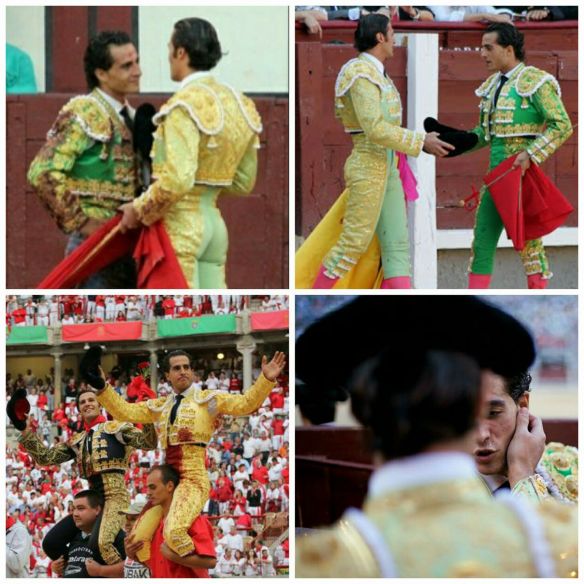
Pingback: THE LAST ARENA: Iván Fandiño: We Who Are About To Die Salute You… – Xander's blog
Pingback: THE LAST ARENA: Iván Fandiño: We Who Are About To Die Salute You… | The Pamplona Post
excellent!
meaning excellent piece. DEP Ivan Fandino
Pingback: Álvaro Múnera: This photo is not what it seems… | The Last Arena
far more than a touch of domecq. you don’t know how to look at bulls and you don’t know your history
Your opinion on the bloodline is not widely shared, my term “a touch” not specific, your choice of place to disagree about this unseemly, and your motivation entirely self-serving. You should, as I remarked to you in my email, be ashamed.
“Así durante los primeros años del cruce, los ejemplares del hierro de Ibán exhibieron una morfología considerablemente alejada del prototipo de Contreras y muy afín al de Domecq. Más tarde se creó un tipo intermedio y en los últimos tiempos la evolución se ha dirigido nuevamente hacia el encaste de Contreras, evidenciando que el cruce no ha quedado bien fijado.”
Sad news, but a good article. I truly cannot understand why people here in my home country (Finland) can be cheering publicly about the death of a great artists (or any human for that matter). Thank you for maintaining this very humane and intelligent blog.